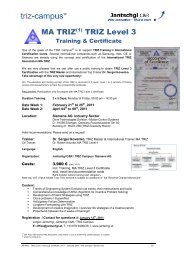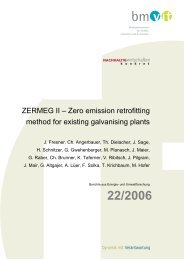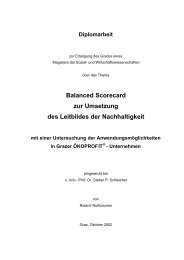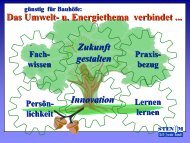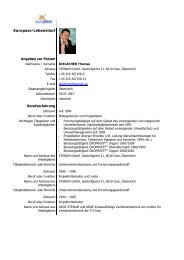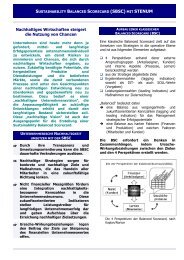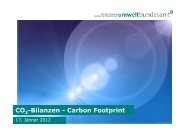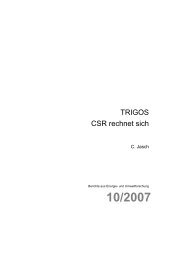Promoting Resource Efficiency in Small & Medium size ... - UNEP
Promoting Resource Efficiency in Small & Medium size ... - UNEP
Promoting Resource Efficiency in Small & Medium size ... - UNEP
Create successful ePaper yourself
Turn your PDF publications into a flip-book with our unique Google optimized e-Paper software.
Case Study:<br />
Ngege Ltd, Uganda (Prepared by NCPC Uganda)<br />
Founded <strong>in</strong> 1989, Ngege today has 250 permanent workers. 25 tons per day of fish are processed to Nile Perch fillets, Tilapia fillets, Head off<br />
Gutted Nile Perch. Ngege Ltd started a <strong>Resource</strong> <strong>Efficiency</strong> project <strong>in</strong> May 2002.<br />
Collection and <strong>in</strong>terpretation of data, conv<strong>in</strong>c<strong>in</strong>g management and workers as well as chang<strong>in</strong>g staff’s attitude dur<strong>in</strong>g implementation were uphill<br />
tasks.<br />
Water consumption before the application of <strong>Resource</strong> <strong>Efficiency</strong> <strong>in</strong> Ngege Ltd was at 11.8 m 3 per tonne of raw fish. Through measures such as<br />
encourag<strong>in</strong>g dry clean<strong>in</strong>g, reduc<strong>in</strong>g cistern water levels from 13 litres to 8 litres, <strong>in</strong>stall<strong>in</strong>g pressure guns on hosepipes and ensur<strong>in</strong>g overall<br />
preventive ma<strong>in</strong>tenance, water consumption has improved to 8.2 m 3 per tonne of fish, achiev<strong>in</strong>g a reduction of 30.5% <strong>in</strong> water consumption<br />
and thus sav<strong>in</strong>g the company US$6,338 per year. This means that Ngege Ltd has effectively reduced the amount of water used and effluent<br />
discharged. Further improvement is expected with additional implementation of other measures such as <strong>in</strong>stallation of sensors and sub<br />
meter<strong>in</strong>g all sections of the plant to improve further monitor<strong>in</strong>g of water use.<br />
Case Study<br />
4.4 CHECKLIST: Water sav<strong>in</strong>g<br />
4.4.1 Transportation<br />
• For clean<strong>in</strong>g of vehicles use efficient spray nozzles with<br />
automatic shutoffs on the end of hoses.<br />
• Consider high-pressure washers to clean more quickly and<br />
efficiently.<br />
• Install a wash-water recycle system for vehicle clean<strong>in</strong>g. Typical<br />
wash-water recycl<strong>in</strong>g systems consist of a sedimentation<br />
bas<strong>in</strong> for grit/sand removal, an oil/water separator, filtration<br />
and a dis<strong>in</strong>fection unit to prevent biological growth.<br />
4.4.2 Toilets/ur<strong>in</strong>als<br />
• Check for leaks every six months.<br />
• Adjust float valve to use as little water as possible without<br />
imped<strong>in</strong>g waste removal or violat<strong>in</strong>g the manufacturer’s<br />
recommendations.<br />
• Replac<strong>in</strong>g older commodes with High-<strong>Efficiency</strong> Toilets (HET)<br />
or at least 1.6 gallons per flush (gpf) / 6 litres per flush (lpf)<br />
models will provide the most water sav<strong>in</strong>gs. Most HET or 1.6<br />
gpf replacements will offer a payback period of less than three<br />
years.<br />
• Use non-potable water for flush<strong>in</strong>g, where codes and health<br />
departments permit.<br />
Gravity flush toilets:<br />
• Adjust ball-float position: to reduce the water level <strong>in</strong> the<br />
cistern, adjust the position of the ball float along the float arm<br />
of the ball/float valve. This improvement can save up to 0.3 gpf<br />
per 1 lpf.<br />
• Install cistern volume adjusters: displacement devices,<br />
<strong>in</strong>clud<strong>in</strong>g bags, bricks or bottles, can reduce water flow by<br />
approximately 0.75 gpf per 2.5 lpf. They function by displac<strong>in</strong>g<br />
flush water stored <strong>in</strong> the cistern.<br />
• Install cistern dam: flexible synthetic material partitions the<br />
cistern, can reduce water flow by approximately 0.75 gpf (=2.5<br />
lpf)<br />
• Dual-flush adapters allow users to use a standard flush for solids<br />
removal or a modified smaller flush for liquid and paper. Dualflush<br />
adapters can save between 0.6 to 1.2 gpf / 2.2 to 4.5 lpf.<br />
Ur<strong>in</strong>als:<br />
• Check for leaks every six months.<br />
• For tank style ur<strong>in</strong>als, check the rubber diaphragm for leaks or<br />
wear, and replace as needed.<br />
• A timer can be <strong>in</strong>stalled to stop water flow when a facility is not<br />
occupied; this can reduce water use by over 75%.<br />
• Adjust float valve or timer to use as little water as possible<br />
without imped<strong>in</strong>g waste removal or violat<strong>in</strong>g the manufacturers<br />
recommendations.<br />
• Use electronic eye or passive <strong>in</strong>frared sensors to flush<br />
automatically; this can reduce water use over 75%.<br />
• Use non-potable water for flush<strong>in</strong>g, where codes and health<br />
departments permit.<br />
• Waterless ur<strong>in</strong>als – retrofit: a siphonic trap conta<strong>in</strong><strong>in</strong>g a barrier<br />
fluid is <strong>in</strong>serted <strong>in</strong> the ur<strong>in</strong>al bowl. The ur<strong>in</strong>e passes through<br />
the siphon and dra<strong>in</strong>s to sewer, while the low-density barrier<br />
fluid (a deodoris<strong>in</strong>g dis<strong>in</strong>fectant) rema<strong>in</strong>s <strong>in</strong> the siphon.<br />
4.4.3 Taps/shower<br />
Taps:<br />
• Adjust flow valves to the tap. Keep <strong>in</strong> m<strong>in</strong>d this modification<br />
can also be easily changed by users.<br />
• Check regularly for leaks.<br />
• Use aerators for taps flow control. The design of the nozzle<br />
mixes air with the water under pressure. When the water exits<br />
the nozzle the air expands, <strong>in</strong>creas<strong>in</strong>g the apparent water flow.<br />
Water sav<strong>in</strong>gs of up to 2.6 gpm or 10 litres/m<strong>in</strong>.<br />
• Install flow restrictors. Flow restrictors can be <strong>in</strong>stalled <strong>in</strong> the<br />
hot and cold water feed l<strong>in</strong>es to the tap. Common flow rate<br />
designs <strong>in</strong>clude 0.5, 0.75, 1 and 1.5 gpm. Flow restrictors can<br />
be used where aerators cannot be used or where the tap is<br />
be<strong>in</strong>g abused. Water sav<strong>in</strong>gs of up to 2,6 gpm or 10 litres/m<strong>in</strong>.<br />
• Install self-clos<strong>in</strong>g taps (push-down taps). To deliver flow, the<br />
user pushes down on the tap head. When the user removes<br />
40



